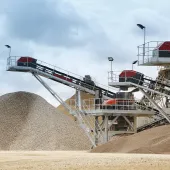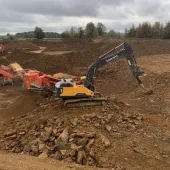Long-term wildlife survey comes to an end

Comprehensive results set to form part of Highthorn surface mine planning application
A LONG-running bird and wildlife survey on and around the site of the proposed new Highthorn surface mine in south-east Northumberland drew to a close last month.
As part of developing their proposals for the mine, Banks Mining commissioned specialist North East ecological consultancy Argus Ecology and environmental consultants Wardell Armstrong to carry out a comprehensive survey of the area to quantify its use through the seasons by all forms of wildlife.
The survey has been ongoing since the winter of 2012 in order to provide a wide-ranging dataset that allows year-on-year comparisons to be made, and while the work has focused primarily on birds, due to their predominance in the area, other forms of wildlife have been included too.
The Argus Ecology team also used a new environmental DNA method to test for the presence of newts during their time on site.
The final tranche of Argus’s survey work took place in June, with reports on their findings and how local habitats could best be managed during the Highthorn project if it gets the go-ahead are set to be included in the planning application that is expected to be submitted later this year.
The proposed Highthorn surface mining scheme would be located to the south east of the village of Widdrington, inland from Druridge Bay, and would run for between eight and 10 years from the proposed start of operations in 2016 through to the completion of restoration.
Kevin Honour, director at Argus Ecology, said: ‘The primary focus has been around geese and wading birds, which reflects priorities in the Druridge Bay area, but with many other species of fauna present in the area, we’ve also monitored their use of the areas in and around the Highthorn site.’
Chris Rogers, technical director at Wardell Armstrong, added: ‘Gathering more than two years’ worth of data more than matches with the demands of the local planning authorities for this sort of survey work, and enables accurate, quantifiable data comparisons to be made for the same seasons in different years, which can then be used to help identify the best way to both protect and enhance existing habitats and create new ones.’
Mark Dowdall, environment and community director at The Banks Group, said: ‘As a major local employer that has worked in Northumberland for more than 30 years, we know this long-standing coalfield area extremely well, and with its proximity to the popular beach and wildlife attractions at Druridge Bay, we understand that the Highthorn proposal is in a unique and sensitive location.
‘The survey work that’s been undertaken over the last two and a half years provides a very clear and properly quantified picture of wildlife use of the area, as well as local habitats, and is helping us to develop appropriate plans to protect and enhance the area to maintain suitable habitats during operational work on the site, if it is granted planning permission.’









